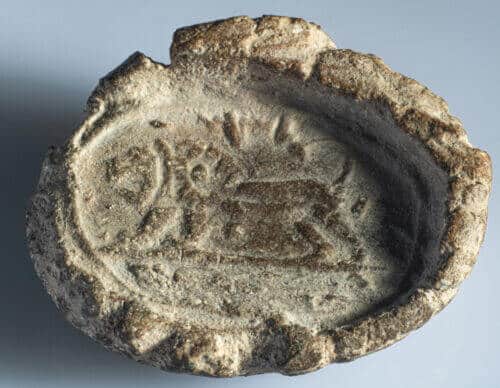After a secret and in-depth study it was revealed for the first time that a seal sold in the market to a professor from Ben-Gurion University of the Negev is actually the earliest find of a seal discovered in the Land of Israel. Also, for the first time in the history of research, there is real evidence of a royal seal that is produced in different sizes

About fifty years ago, Prof. Yigal Ronan from Ben-Gurion University of the Negev was walking around the fake market in Be'er Sheva and came across an oval piece of material with a seal impression and an image of a roaring lion standing on all fours. Prof. Ronan asked the merchant where the stamp came from, but the seller did not know how to answer and agreed to sell it for only ten old shekels.
Intriguingly, Prof. Ronan noticed that this stamp bears, above the roaring fabric and below it, the word "to hear", and it is suspiciously similar to the famous seal from Magido "to hear the servant of Jeroboam". This seal was published in 1904 and aroused great interest in the world because it is the largest and most magnificent of the Hebrew seals discovered to date.
The fact that the bulla was sold in a folk market and at a measly price immediately raised the concern that it was not an original and ancient find, however Prof. Ronan decided to present it to researchers dealing with the subject in order to check its authenticity. The tests were carried out in a strict manner with the cooperation of researchers from the Ben-Gurion University of the Negev, the Geological Institute in Jerusalem and the Antiquities Authority. The names of the researchers who assisted in the research: Prof. Eliezer Oren, Prof. Shmuel Ahitov, Prof. Eliezer Oren, from Ben-Gurion University of the Negev; Dr. Avner Ilon and Dr. Mira Bar-Matios from the Geological Institute in Jerusalem; Dr. Orit Shamir from the Antiquities Authority of the State of Israel.
The laboratory tests taught that the bulla was formed from soil taken from an environment where limestone rocks are exposed in close proximity to basalts containing olivine, which corresponds to the areas in the lower Galilee and the Jezreel and Beit Shan valleys. It was also found that the bulla was stamped on top of a linen fabric when its material was relatively dry and then attached at a temperature of about 750 degrees Celsius. The lobule has an oval outline (oval) and its maximum dimensions are 23.4 X 19.3 mm. The area of the imprint is about 20 x 15 mm and its thickness is about 4 mm in the area of the imprint and about 6 mm in the raised edges. The bulla is coated, mainly on the side of the impression but also on the edge and the back and especially in the depressions, with a layer of grayish-white patina. This accumulated over time, after the creation of the stamp was finished. According to the totality of these data and many other data, it was found that the stamp is indeed authentic and original.

Following the discovery, the Ronan family agreed to hand over the stamp to the state authority and put it on display at the Israel Museum.
The importance of the discovery of the bulla is enormous and threefold: First, just as the 'Leshma' seal is today the oldest of the Hebrew royal seals, the bulla is the earliest of the historical seal impressions discovered in the Land of Israel. Second, for the first time in the history of research, real evidence of a royal seal that was produced in different sizes was revealed. Thirdly, this is the first and only archaeological find of its kind from the Iron Age in the Land of Israel.
It is worth noting that the seal from Megiddo is almost double the size of the seal that sealed the stamp. It can be assumed that the seal stamped in the stamp was actually a reduced version of a seal from the same series that was used by a high-ranking official in the Kingdom of Israel. The stamp signed with the seal of Shema Abed Jeroboam, which is not the same as the seal from Megiddo, indicates that 'Shema Abed Jeroboam' had more than one seal. His seals were not personal seals, but official seals of a senior official in the state administration of King Jeroboam II of Israel. His seals were used by him and his officials to sign documents and shipments of goods in his name.

3 תגובות
Fifty years ago there were no shekels but liras
https://he.wikipedia.org/wiki/%D7%9C%D7%99%D7%A8%D7%94_%D7%99%D7%A9%D7%A8%D7%90%D7%9C%D7%99%D7%AA
"The importance of the discovery of the bulla is enormous and threefold" - there is nothing huge about the discovery of the bulla. But it is interesting and gives another clue to the Tanakh period.
Everything is written in the Torah. We are not waiting for one or another researcher to come and "discover" what we already know.
Don't wait for investigators to know the truth. There is nothing new under the sun.